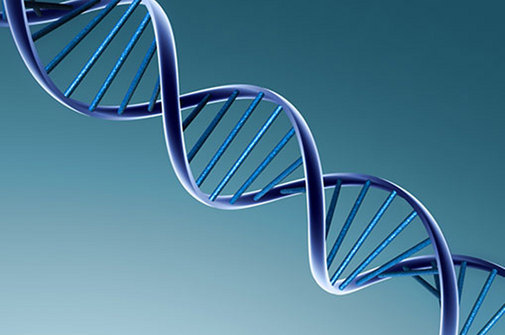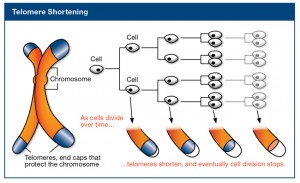Telomeres were first discovered when analyzing a freshwater protozoa called Tetrahymena. A telomere is protective cap at the end of a piece of DNA that protects the chromosome from breaking down (Armanios 2010). Without this cap many genetic problems would occur, making telomeres very important. However, each time a cell undergoes mitosis, telomeres shorten. Once they become too short to function, a signal that the DNA has been damaged rings out and the cell no longer divides (Blackburn et al. 2015).Telomere length is very important, as it can influence a person’s health. Shorter telomeres have been associated with a variety of age-related diseases, such being more prone to “coronary or infectious disease” as well as others (Graakjaer et al. 2004) (Mitteldorf 2013). Unfortunately, telomeres naturally shorten as we age. Additionally, telomeres in male humans appear to shorten at twice the rate of telomeres in females, which may explain why women live longer than men in many societies (Unryn et al. 2005). While they can be elongated by an enzyme called telomerase, this is “usually diminished after birth” (Hiyama et al. 2007). However, a bivalve muscle called the Ocean Quahog, or Artica islandica, has continually regenerating telomeres. It is the “longest-lived non-colonial animal on earth” (Gruber et al. 2013). The oldest specimen found was 507 years old, which makes it the oldest living animal ever discovered. A study done on the Ocean Quahog concluded that the animal’s high level of telomerase activity, an enzyme that lengthens telomeres, may be why it has such long telomeres. Additional health problems such as cancer may even occur in humans if telomeres are elongated when they should not be (Cagatay et al. 2013). Additionally, telomeres may be prematurely shortened if a person is under long-term chronic stress (Epel et al. 2004). Because of this, telomeres may act as a biological clock for our cells, determining their lifespan and explaining how telomere length “correlates inversely with age” (Kaszubowska 2008). But how is telomere length determined? The length of a person’s telomeres appears to be strongly related to the telomere length of their parents (Graakjaer et al. 2004). With increasing research linking telomere length to human health, it is clear that lifestyle has an effect on genetic health, although more research is needed to determine whether “shorter telomeres are just a sign of aging….or actually contribute to aging” (Boyle 2013). While telomere length influences a person’s lifespan, it can be influenced as well. As a result, the research of telomeres is an ongoing process, which will likely result in many interesting and helpful discoveries.
“Telomere Shortening”
“…telomeres shorten and eventually cell division stops.”
References
Armanios, Mary [Internet]. 2010, Feb 9. Syndromes of telomere shortening. NCBI; [Cited 2016 Mar 9]. Available from:http://www.ncbi.nlm.nih.gov/pmc/articles/PMC2818564/
Boyle MM. 2013. Telomeres, cancer and ageing. Journal of the Australian Traditional-Medicine Society [Internet]. [cited 2016 Mar 8]; 19(3): 154-159. Available from: http://eds.b.ebscohost.com/eds/pdfviewer/pdfviewer?vid=7&sid=a1e656cf-358c-4c0a-8ac1-826ec222a351%40sessionmgr113&hid=127
Cagatay G, Lenhard KR. 2013. The Role of Telomeres in Stem Cells and Cancer. Cell. [Internet]. [cited 2016 Mar 8]; 152(3): 390–393. Available from: http://www.sciencedirect.com/science/article/pii/S0092867413000160#bib2 doi: 10.1016/j.cell.2013.01.010
DNA double helix. DNA, the caduceus & double helixes. [Internet] [cited 25 Mar 2016]. Available from: https://venusianfire.wordpress.com/2009/11/25/dna-the-caduceus-double-helixes/
Epel E, Blackburn E, Lin J, Dhabhar F, Adler N, Morrow J, Cawthon R. 2004. Accelerated telomere shortening in response to life stress. Proceedings of the National Academy of Sciences of the United States of America. [Internet]. [March 2, 2016]; 10 (49): 17312-17315. Available from: http://www.pnas.org/content/101/49/17312.full.10.1073/pnas.0407162101
Graakjaer J, Pascoe L, Der-Sarkissian H, Thomas G, Kolvraa S, Christensen K, Londño-Vallejo A. 2004. The relative lengths of individual telomeres are defined in the zygote and strictly maintained during life. Aging Cell [Internet]. [March 2, 2016]; 3 (3): 97-102. Available from: http://onlinelibrary.wiley.com/doi/10.1111/j.1474-9728.2004.00093.x/full. 10.1111/j.1474-9728.2004.00093.x.
Gruber H, Schaible R, Ridgway ID, Chow TT, Held C, Philipp EE. Telomere-independent ageing in the longest-lived non-colonial animal, Arctica islandica. [Internet].[cited 2016 March 10th] 2014;51:38–45. Available from: http://www.sciencedirect.com/science/article/pii/S0531556513003707
Hiyama E, Hiyama K. 2007. Telomere and telomerase in stem cells. Br J Cancer. [Internet]. [cited 2016 Mar 8]; 96(7): 1020–1024. Available from: http://www.ncbi.nlm.nih.gov/pmc/articles/PMC2360127/ doi: 10.1038/sj.bjc.6603671
Kaszubowska L. 2008. Telomere shortening and ageing of the immune system. J Physiol Pharmacol. [Internet]. [cited 2016 Mar 8]; 59(9): 169-86. Available from: http://www.jpp.krakow.pl/journal/archive/12_08_s9/pdf/169_12_08_s9_article.pdf
Mitteldorf, J.J. 2013. Telomere biology: firewall or aging clock? Biochemistry Mosc. [Internet]. [March 9, 2016]; 78 (9): 1054-60. Available from http://eds.b.ebscohost.com/eds/pdfviewer/pdfviewer?sid=1af9b3b3-e893-4c4b-8971-5d7a969dc89f%40sessionmgr110&vid=2&hid=108. 10. 1134/S0006297913090125.
Telomere shortening. Whole Health Insider [Internet] [cited 29 Mar 2016]. Available from http://www.wholehealthinsider.com/newsletter/2012/a-genetic-solution-to-slowing-aging-and-preventing-disease/

